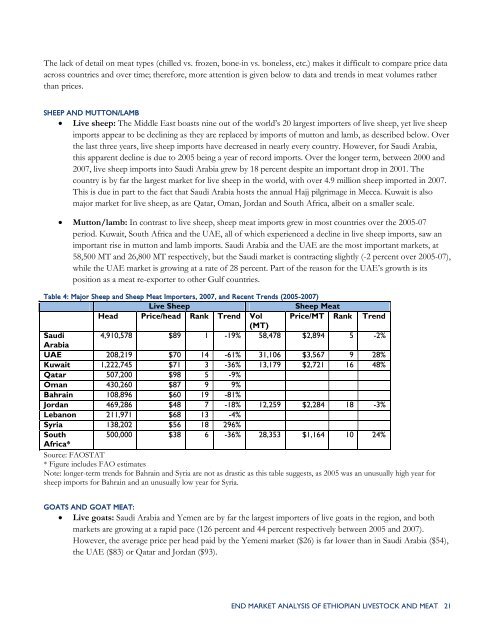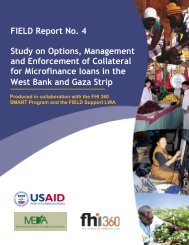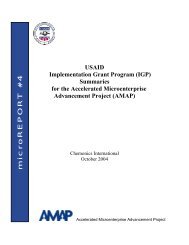End Market Analysis of Ethiopian Livestock and ... - USAID Microlinks
End Market Analysis of Ethiopian Livestock and ... - USAID Microlinks
End Market Analysis of Ethiopian Livestock and ... - USAID Microlinks
Create successful ePaper yourself
Turn your PDF publications into a flip-book with our unique Google optimized e-Paper software.
The lack <strong>of</strong> detail on meat types (chilled vs. frozen, bone-in vs. boneless, etc.) makes it difficult to compare price data<br />
across countries <strong>and</strong> over time; therefore, more attention is given below to data <strong>and</strong> trends in meat volumes rather<br />
than prices.<br />
SHEEP AND MUTTON/LAMB<br />
• Live sheep: The Middle East boasts nine out <strong>of</strong> the world’s 20 largest importers <strong>of</strong> live sheep, yet live sheep<br />
imports appear to be declining as they are replaced by imports <strong>of</strong> mutton <strong>and</strong> lamb, as described below. Over<br />
the last three years, live sheep imports have decreased in nearly every country. However, for Saudi Arabia,<br />
this apparent decline is due to 2005 being a year <strong>of</strong> record imports. Over the longer term, between 2000 <strong>and</strong><br />
2007, live sheep imports into Saudi Arabia grew by 18 percent despite an important drop in 2001. The<br />
country is by far the largest market for live sheep in the world, with over 4.9 million sheep imported in 2007.<br />
This is due in part to the fact that Saudi Arabia hosts the annual Hajj pilgrimage in Mecca. Kuwait is also<br />
major market for live sheep, as are Qatar, Oman, Jordan <strong>and</strong> South Africa, albeit on a smaller scale.<br />
• Mutton/lamb: In contrast to live sheep, sheep meat imports grew in most countries over the 2005-07<br />
period. Kuwait, South Africa <strong>and</strong> the UAE, all <strong>of</strong> which experienced a decline in live sheep imports, saw an<br />
important rise in mutton <strong>and</strong> lamb imports. Saudi Arabia <strong>and</strong> the UAE are the most important markets, at<br />
58,500 MT <strong>and</strong> 26,800 MT respectively, but the Saudi market is contracting slightly (-2 percent over 2005-07),<br />
while the UAE market is growing at a rate <strong>of</strong> 28 percent. Part <strong>of</strong> the reason for the UAE’s growth is its<br />
position as a meat re-exporter to other Gulf countries.<br />
Table 4: Major Sheep <strong>and</strong> Sheep Meat Importers, 2007, <strong>and</strong> Recent Trends (2005-2007)<br />
Live Sheep Sheep Meat<br />
Head Price/head Rank Trend Vol<br />
(MT)<br />
Price/MT Rank Trend<br />
Saudi<br />
Arabia<br />
4,910,578 $89 1 -19% 58,478 $2,894 5 -2%<br />
UAE 208,219 $70 14 -61% 31,106 $3,567 9 28%<br />
Kuwait 1,222,745 $71 3 -36% 13,179 $2,721 16 48%<br />
Qatar 507,200 $98 5 -9%<br />
Oman 430,260 $87 9 9%<br />
Bahrain 108,896 $60 19 -81%<br />
Jordan 469,286 $48 7 -18% 12,259 $2,284 18 -3%<br />
Lebanon 211,971 $68 13 -4%<br />
Syria 138,202 $56 18 296%<br />
South<br />
Africa*<br />
500,000 $38 6 -36% 28,353 $1,164 10 24%<br />
Source: FAOSTAT<br />
* Figure includes FAO estimates<br />
Note: longer-term trends for Bahrain <strong>and</strong> Syria are not as drastic as this table suggests, as 2005 was an unusually high year for<br />
sheep imports for Bahrain <strong>and</strong> an unusually low year for Syria.<br />
GOATS AND GOAT MEAT:<br />
• Live goats: Saudi Arabia <strong>and</strong> Yemen are by far the largest importers <strong>of</strong> live goats in the region, <strong>and</strong> both<br />
markets are growing at a rapid pace (126 percent <strong>and</strong> 44 percent respectively between 2005 <strong>and</strong> 2007).<br />
However, the average price per head paid by the Yemeni market ($26) is far lower than in Saudi Arabia ($54),<br />
the UAE ($83) or Qatar <strong>and</strong> Jordan ($93).<br />
END MARKET ANALYSIS OF ETHIOPIAN LIVESTOCK AND MEAT 21





